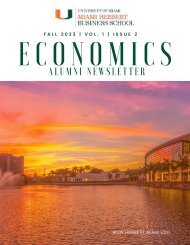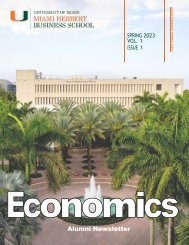Spring 2024 Alumni Newsletter
You also want an ePaper? Increase the reach of your titles
YUMPU automatically turns print PDFs into web optimized ePapers that Google loves.
2000 onward, the U.S. debt continued to grow at an historically rapid pace. Despite<br />
From<br />
growing debt, inflation remained low and long-term interest rates continued their<br />
the<br />
answer is that the domestic and global demand for U.S. Treasury securities (USTs)<br />
One<br />
rapidly over this period of time. There were several forces driving this demand. First, a<br />
grew<br />
growth in the demand for USTs for use as collateral in credit derivative and repo<br />
secular<br />
began in the 1970s. Second, many emerging countries began to load up on USTs<br />
markets<br />
safe stores of value, especially after experiencing or witnessing several financial crises.<br />
as<br />
Asian financial crisis of 1997, for example, motivated China’s rapid accumulation of<br />
The<br />
The Chinese demand for USTs was accommodated by China’s entry into the World<br />
USTs.<br />
Organization in 2000. In effect, China exported cheap goods and services (a<br />
Trade<br />
demand for USTs continued to grow, spurred on by events like the 2008-09 financial<br />
The<br />
which saw the evaporation of a large supply of private-label safe assets, leaving<br />
crisis,<br />
seeking safe havens to reach for USTs. In the aftermath of the financial crisis, a<br />
those<br />
of important regulatory reforms (e.g., Basel III and Dodd-Frank) contributed to a<br />
number<br />
demand for USTs. More recently, the establishment of the Fed’s Standing Repo<br />
regulatory<br />
and the FIMA repo facility permit UST holders to borrow USD using USTs as<br />
Facility<br />
further enhancing the attractiveness of USTs. Together, these developments<br />
collateral,<br />
to a secular deflationary force in the United States. The downward pressure on<br />
contributed<br />
upshot of this interpretation of U.S. interest rates and inflation is that while the supply<br />
The<br />
USTs (deficit) matters, so does the domestic and foreign demand for USTs. To infer the<br />
of<br />
path of interest rates and inflation in the future, it will be important to account for the<br />
likely<br />
likely to impinge on the future supply of and demand for USTs.<br />
forces<br />
March 2020, parts of the economy were shut down to “flatten the contagion curve.” The<br />
In<br />
emergency lending facilities stabilized financial markets and the CARES Act (with<br />
Fed’s<br />
from the Federal Reserve) injected close to $2.5 trillion (10% GDP) of support<br />
support<br />
targeting mainly to those who needed the money. Although these support<br />
payments<br />
could have been designed better, they were obviously necessary and desirable.<br />
payments<br />
while there was good reason to believe that the policy would drive up the cost of<br />
And<br />
I explained in the Fall of 2020 how inflation was an unfortunate byproduct of a<br />
living,<br />
policy financed by printing money instead of raising tax rates and/or interest<br />
redistribution<br />
The alternative methods of financing the necessary transfers would likely have<br />
rates.<br />
even more pain on the economy, primarily though a persistently higher rate of<br />
afflicted<br />
secular decline. How was this possible?<br />
disinflationary force) to the United States in exchange for USTs.<br />
interest rates and inflation were largely offset by an accommodating fiscal policy.<br />
Events since 2019<br />
unemployment.




